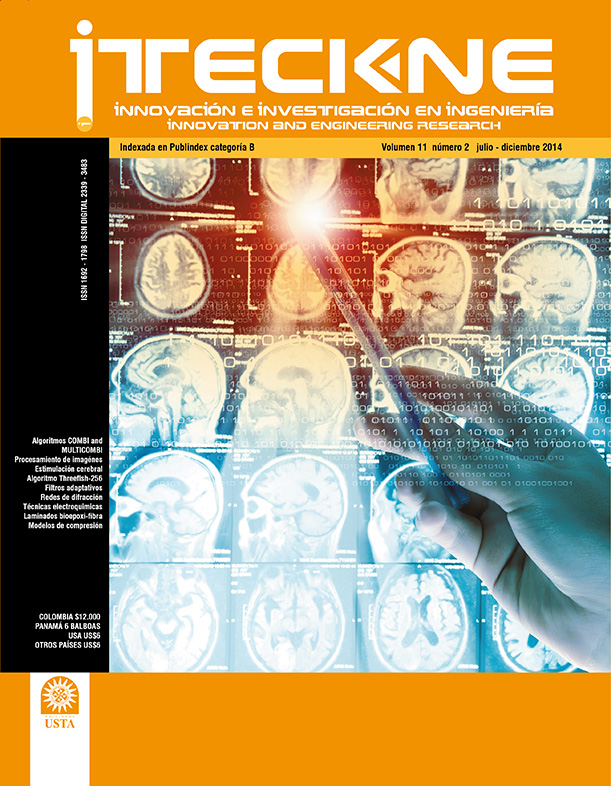Fetal electrocardiogram extraction using hybrid BSS technique: COMBI and MULTICOMBI algorithms
DOI:
https://doi.org/10.15332/iteckne.v11i2.718Palabras clave:
Abdominal ECG, COMBI, fetal ECG, MULTICOMBI, SER, SIRResumen
In this paper, we use two algorithms for obtaining fetal ECG from abdominal ECG. The algorithms are MULTICOMBI and COMBI, which are a combination of EFICA and WASOBI algorithms. The performance of the algorithms COMBI, MULTICOMBI, WASOBI, EFICA and traditional JADE algorithm are compared. A semi synthetic database and two actual databases are used to compare the performance of algorithms using as parameter the signal to error ratio SER. It is found that the COMBI and MULTICOMBI algorithms show better performance than the JADE, EFICA and WASOBI algorithms.Descargas
Citas
L. Hui and D. W. Bianchi, “Prenatal pharmacotherapy for fetal anomalies: a 2011 update,” Prenat. Diagn., vol. 31, no. 7, pp. 735–743, 2011.
R. A. Shepoval’nikov, A. P. Nemirko, A. N. Kalinichenko, and V. V. Abramchenko, “Investigation of time, amplitude, and frequency parameters of a direct fetal ECG signal during labor and delivery,” Pattern Recognit. Image Anal., vol. 16, no. 1, pp. 74–76, 2006.
N. J. Outram, E. C. Ifeachor, P. W. J. Van Eetvelt, and S. H. Curnow, “Techniques for optimal enhancement and feature extraction of fetal electrocardiogram,” IEE Proc.-Sci. Meas. Technol., vol. 142, no. 6, pp. 482–489, 1995.
Y. C. Park, K. Y. Lee, D. H. Youn, N. H. Kim, W. K. Kim, and S. H. Park, “On detecting the presence of fetal R-wave using the moving averaged magnitude difference algorithm,” IEEE Trans. Biomed. Eng., vol. 39, no. 8, pp. 868–871, 1992.
R. Sameni, M. B. Shamsollahi, C. Jutten, and G. D. Clifford, “A nonlinear Bayesian filtering framework for ECG denoising,” Biomed. Eng. IEEE Trans. On, vol. 54, no. 12, pp. 2172–2185, 2007.
W. Zheng, H. Liu, A. He, X. Ning, and J. Cheng, “Singlelead fetal electrocardiogram estimation by means of combining R-peak detection, resampling and comb filter,” Med. Eng. Phys., vol. 32, no. 7, pp. 708–719, 2010.
A.Khamene and S. Negahdaripour, “A new method for the extraction of fetal ECG from the composite abdominal signal,” Biomed. Eng. IEEE Trans. On, vol. 47, no. 4, pp. 507–516, 2000.
P. P. Kanjilal, S. Palit, and G. Saha, “Fetal ECG extraction from single-channel maternal ECG using singular value decomposition,” Biomed. Eng. IEEE Trans. On, vol. 44, no. 1, pp. 51–59, 1997.
V. Zarzoso, A. K. Nandi, and E. Bacharakis, “Maternal and foetal ECG separation using blind source separation methods,” Math. Med. Biol., vol. 14, no. 3, pp. 207–225, 1997.
M. Richter, T. Schreiber, and D. T. Kaplan, “Fetal ECG extraction with nonlinear state-space projections,” Biomed. Eng. IEEE Trans. On, vol. 45, no. 1, pp. 133–137, 1998.
B. Widrow, J. R. Glover Jr, J. M. McCool, J. Kaunitz, C. S. Williams, R. H. Hearn, J. R. Zeidler, E. Dong Jr, and R. C. Goodlin, “Adaptive noise cancelling: Principles and applications,” Proc. IEEE, vol. 63, no. 12, pp. 1692–1716, 1975.
P. Tichavskỳ, Z. Koldovskỳ, E. Doron, A. Yeredor, and G. Gómez-Herrero, “Blind signal separation by combining two ICA algorithms: HOS-based EFICA and time structure-based WASOBI.” Florence: Eur. Signal Process. Conf. (EUSIPCO), 2006.
P. Tichavsky, Z. Koldovsky, A. Yeredor, G. Gómez-Herrero, and E. Doron, “A hybrid technique for blind separation of non-Gaussian and time-correlated sources using a multicomponent approach,” Neural Netw. IEEE Trans. On, vol. 19, no. 3, pp. 421–430, 2008.
J.-F. Cardoso and A. Souloumiac, “Blind beamforming for non-Gaussian signals,” in IEE Proceedings F (Radar and Signal Processing), vol. 140, pp. 362–370, 1993.
A.Yeredor, “Blind separation of Gaussian sources via second-order statistics with asymptotically optimal weighting,” Signal Process. Lett. IEEE, vol. 7, no. 7, pp. 197–200, 2000.
Z. Koldovsky, P. Tichavsky, and E. Oja, “Efficient variant of algorithm FastICA for independent component analysis attaining the Cramér-Rao lower bound,” Neural Netw. IEEE Trans. On, vol. 17, no. 5, pp. 1265– 1277, 2006.
A.Belouchrani, K. Abed-Meraim, J.-F. Cardoso, and E. Moulines, “A blind source separation technique using second-order statistics,” Signal Process. IEEE Trans. On, vol. 45, no. 2, pp. 434–444, 1997.
I. Hyvarinen, “Fast and robust fixed-point algorithms for independent component analysis,” Neural Netw. IEEE Trans. On, vol. 10, no. 3, pp. 626–634, 1999.
D. Taralunga, M. Ungureanu, R. Strungaru, and W. Wolf, “Performance comparison of four ICA algorithms applied for fECG extraction from transabdominal recordings,” in Signals, Circuits and Systems (ISSCS), 2011 10th International Symposium on, pp. 1–4, 2011.
K. V. K. Ananthanag and J. S. Sahambi, “Investigation of blind source separation methods for extraction of fetal ECG,” in Electrical and Computer Engineering, 2003. IEEE CCECE 2003. Canadian Conference on, vol. 3, pp. 2021–2024, 2003.
R. Romo Vázquez, H. Vélez-Pérez, R. Ranta, V. Louis Dorr, D. Maquin, and L. Maillard, “Blind source separation, wavelet denoising and discriminant analysis for EEG artefacts and noise cancelling,” Biomed. Signal Process. Control, vol. 7, no. 4, pp. 389–400, 2012.
M. K. Nath and J. S. Sahambi, “Independent component analysis of functional MRI data,” in TENCON 2008-2008 IEEE Region 10 Conference, pp. 1–6, 2008.
P. Waldmann, “Of ‘cocktail parties’ and exoplanets,” Astrophys. J., vol. 747, no. 1, p. 12, 2012.
L. O. Sarmiento Álvarez, A. González, and J. Millet, “Synthetic database for testing algorithms of fetal ECG extraction from abdominal ECG,” in Image, Signal Processing, and Artificial Vision (STSIVA), 2012 XVII Symposium of, pp. 56–61, 2012.
R. Sameni, G. D. Clifford, C. Jutten, and M. B. Shamsollahi, “Multichannel ECG and noise modeling: application to maternal and fetal ECG signals,” EURASIP J. Adv. Signal Process, 2007.
R. Sameni, C. Jutten, and M. B. Shamsollahi, “A deflation procedure for subspace decomposition,” Signal Process. IEEE Trans. On, vol. 58, no. 4, pp. 2363–2374, 2010.
A. L. Goldberger, L. A. Amaral, L. Glass, J. M. Hausdorff, P. C. Ivanov, R. G. Mark, J. E. Mietus, G. B. Moody, C.-K. Peng, and H. E. Stanley, “Physiobank, physiotoolkit, and physionet components of a new research resource for complex physiologic signals,” Circulation, vol. 101, no. 23, pp. e215–e220, 2000.
Descargas
Publicado
Cómo citar
Número
Sección
Licencia
La revista ITECKNE se encuentra registrada bajo una licencia de Creative Commons Reconocimiento-NoComercial 4.0 Internacional Por lo tanto, esta obra se puede reproducir, distribuir y comunicar públicamente, siempre que se reconozca el nombre de los autores y a la Universidad Santo Tomás. Se permite citar, adaptar, transformar, autoarchivar, republicar y crear a partir del material, siempre que se reconozca adecuadamente la autoría, se proporcione un enlace a la obra original y se indique si se han realizado cambios.
La Revista ITECKNE no retiene los derechos sobre las obras publicadas y los contenidos son responsabilidad exclusiva de los autores, quienes conservan sus derechos morales, intelectuales, de privacidad y publicidad. Sin embargo esta facultada para editar, publicar, reproducir y distribuir tanto en medios impresos como digitales, además de incluir el artículo en índices internacionales y/o bases de datos, de igual manera, se faculta a la editorial para utilizar las imágenes, tablas y/o cualquier material gráfico presentado en el artículo para el diseño de carátulas o posters de la misma revista.













